A few years ago, I moved to the center of a mid-sized western town and started spending more time than I should staring out the window. In the sky, circling above big cottonwood trees and barely moving their wings, were dozens and dozens of vultures.
They rarely landed, at least not that I could see. But I couldn’t help that gut feeling: What died, or what is going to die, making them circle like that?
The answer was probably nothing. There was likely no hidden carcass.
And if something was dead, little is better for natural cleanup than a swirling kettle of vultures.
What I noticed were turkey vultures – one of three vulture species in the U.S. and one of only seven in the western hemisphere – making their way from breeding grounds near the Canadian border to their wintering area as far south as Central or South America. Vultures soar and circle even when they’re migrating.
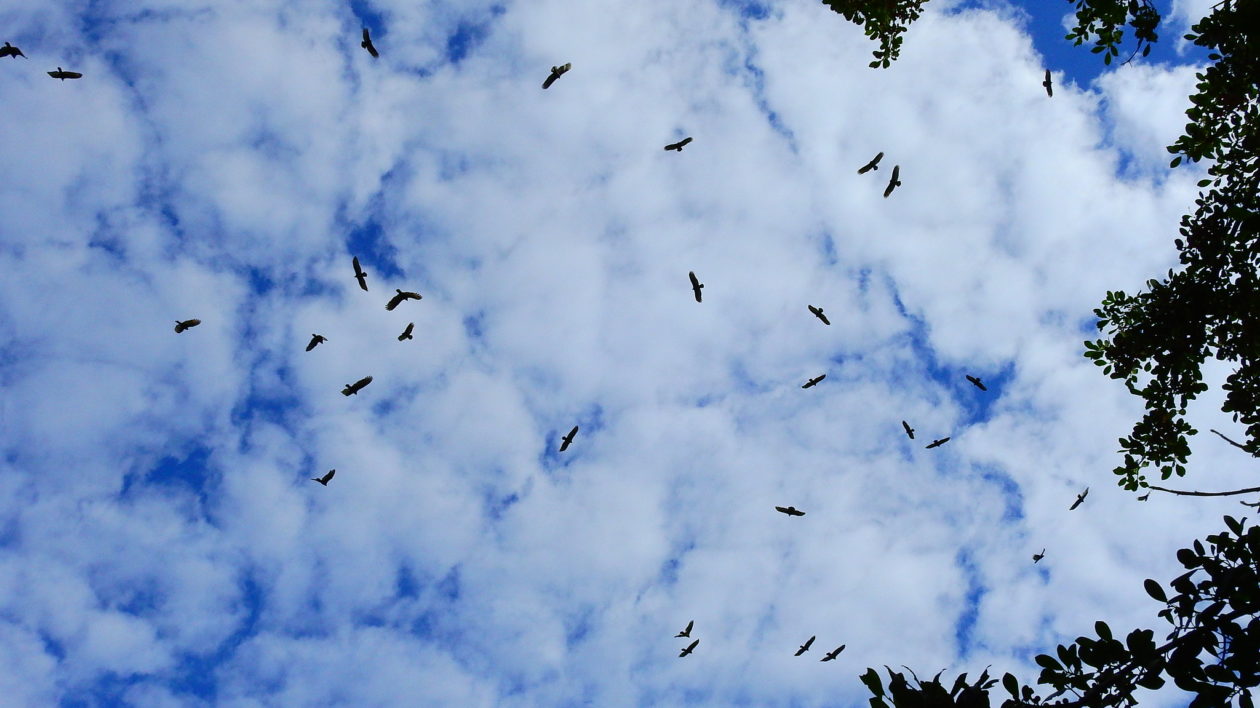
They often leapfrog their residential counterparts in warmer stretches of the U.S., leaving the best sanitizing duties to the locals as they ride thermal waves to warmer places.
I felt guilty for that unnerving feeling that circling vultures brought to my stomach. But I’m not the only one that can’t help thinking vultures are some harbinger of death, says Alex Wehrung, an educator and spokesperson for the Wildlife Center of Virginia. Many people view vultures as repulsive at best and bad omens at worst.
While the job of a vulture may not be the most glamorous – most humans can’t imagine sticking our bald heads inside a dead or rotting carcass – their role in our ecosystems could not be more critical.
“Vultures are incredibly beneficial to have around. They are scavengers and are consuming carrion, which if not picked up by others will rot and decompose and transmit possible bacteria and disease to other animals and humans,” Wehrung says. “While vultures might not look pretty to some people, they certainly help make our habitats much healthier.”
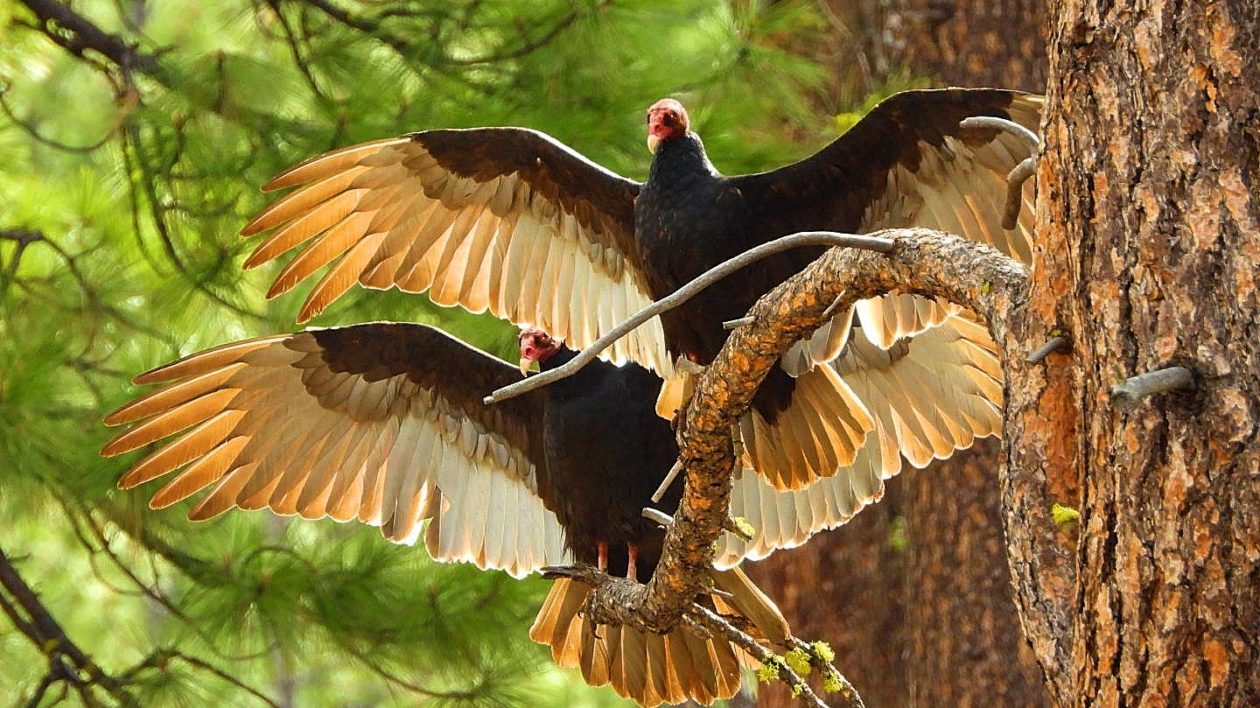
Nature’s Cleaning Crew
The taxonomic identification of vultures in North and South America can be a little confusing. They’re often considered raptors, but scientists believe they may well be more closely related to storks than carnivorous fliers.
The U.S. has three species of vultures – black and turkey vultures and the California condor.
They’re nature’s cleaning crews, says Wahrung, the creatures willing to dig in and rid the ground of carcasses that can otherwise spread diseases, parasites and bacteria.
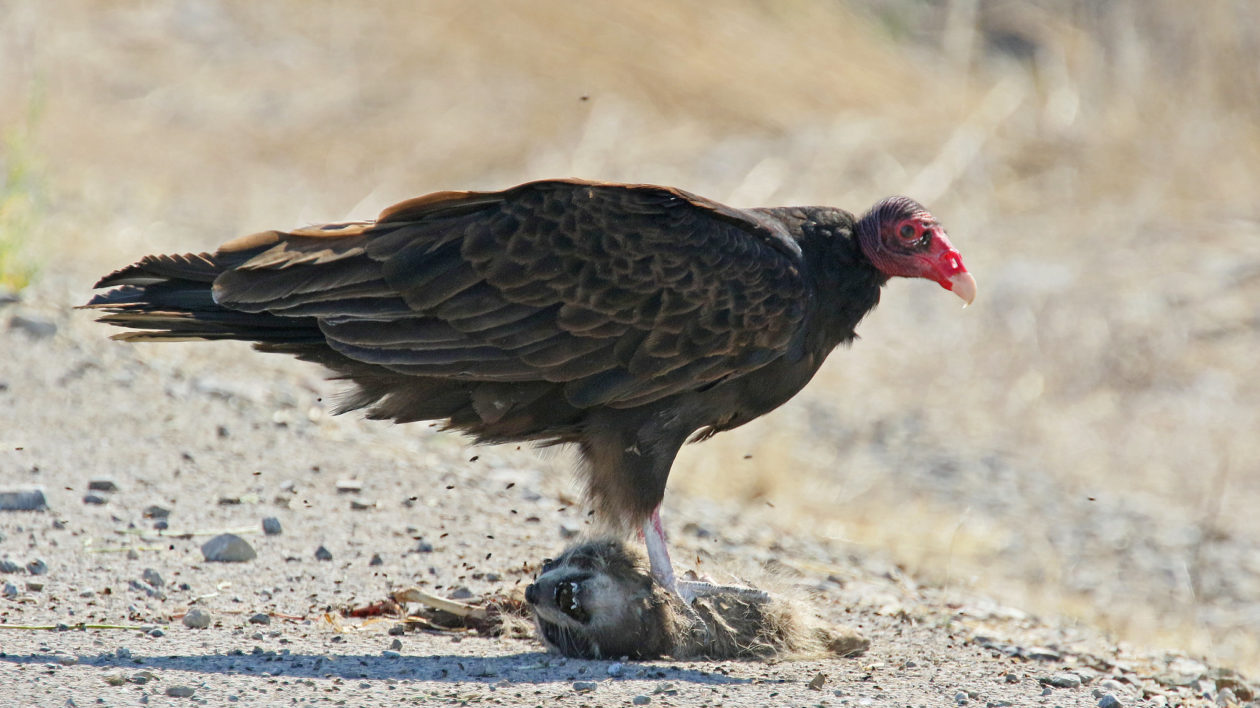
The ones you may see most often from your house or apartment window are either the black or turkey vultures, depending on where you live. Turkey vultures extend coast to coast, and breed as far north as Canada then migrate to South America. Black vultures live largely in the east and southeast U.S., also extending their range into Central and South America. Look closely, and you can tell the difference between eagles and vultures from the way they fly, Wahrung says, perfectly suited to their nearly 6-foot wingspan.
“They are built to soar. They have broad, long wings, which when extended catch those thermal updrafts, which is why we see them migrating over mountain ranges,” he says. “Eagles are powerful fliers with steady beating wings. Vultures soar almost exclusively.”
While soaring, turkey vultures are using their incredible sense of smell to sniff out any potential dead food. It’s so adept, in fact, that in 1938, the Union Oil Company injected an organic chemical called mercaptan into gas line and monitored vulture activity to check for leaks, according to All About Birds, a feature of the Cornell Lab of Ornithology.
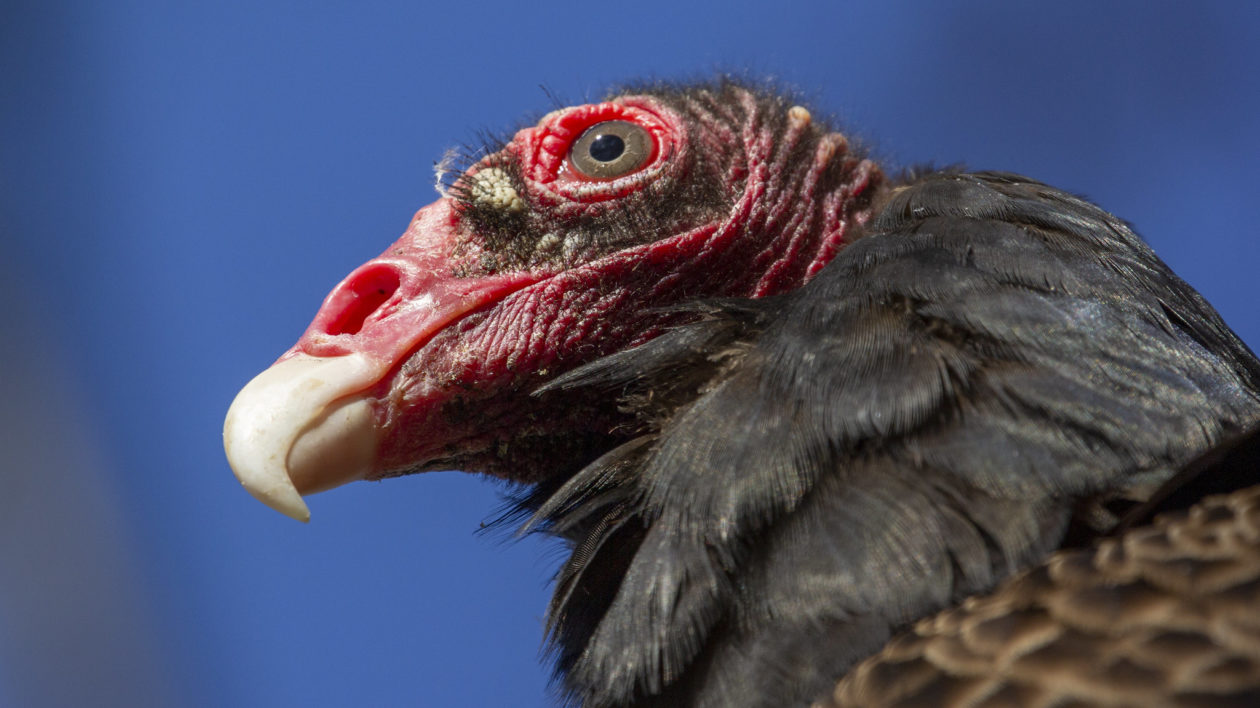
“Some mercaptans smell like rotting cabbage or eggs,” Cornell writes. “To us, mercaptans smell horrible, but for vultures they are associated with fine dining.”
In fact, a 2017 paper published in Scientific Reports showed that turkey vultures have olfactory bulbs (basically the part of the brain that receives information about smell) that are four times as large as the black vulture, even though their brains are 20 percent smaller.
That’s why black and turkey vultures are often seen together. Black vultures rely on their eyes to find food. Turkey vultures do both. When a turkey vulture dives to the ground, black vultures will follow, knowing food is on the way.
Up close, turkey vultures have reddish heads, akin to those on a wild turkey (hence the name) and black vultures have a dark grey featherless head. While the lack of feathers on their heads may seem unsightly – and result in few shirts, hats or flags emblazoned with their image – it’s actually a critical adaptation.
Stick a feathered head in a three-day old dead deer, and the opportunity for harmful bacteria and parasites abounds. Bald heads are uniquely created to slough off any bits.
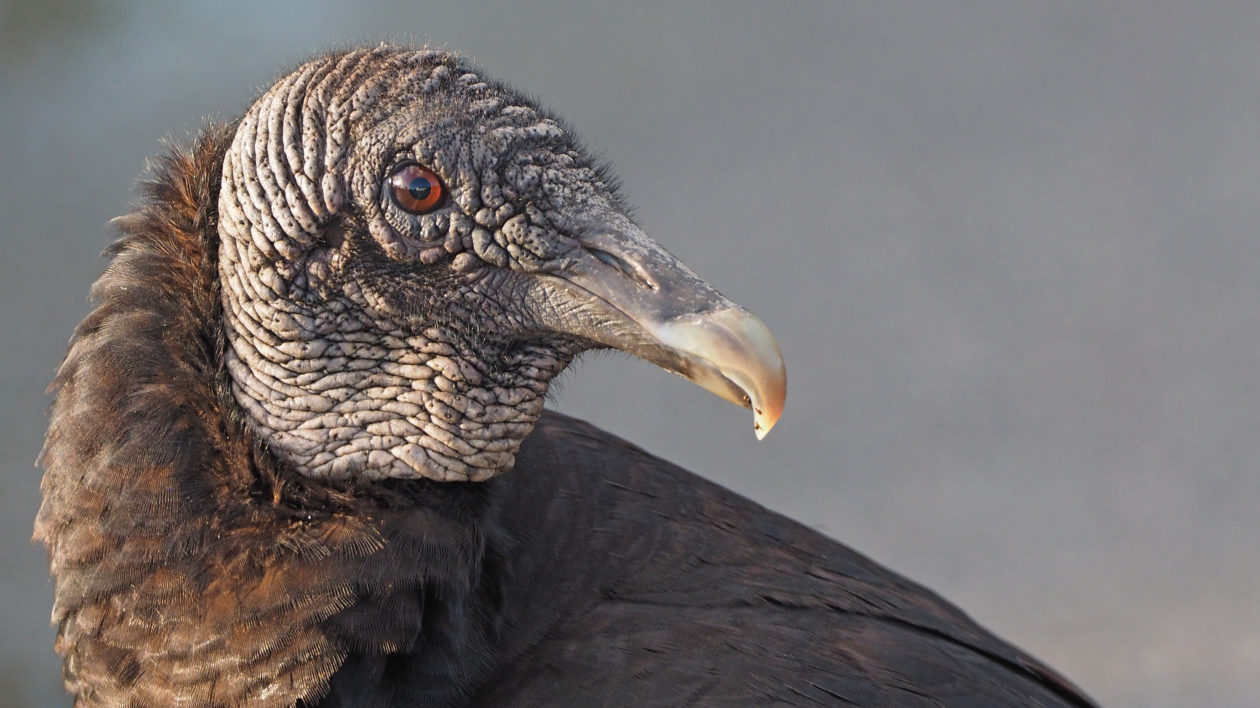
Threats to Vultures
Fortunately for human and landscape health, both turkey and black vulture populations are steady in the U.S. Turkey vultures are even expanding their range as our climate warms. The Teton Raptor Center in northwest Wyoming rarely saw turkey vultures until the last handful of years, a sign of their movement into the area.
Their cousin, the California condor, still languishes on the endangered species list, though new policies banning lead ammunition and condor breeding programs have seen success.
Vultures in Eurasia and Africa are not faring nearly as well. They’re suffering not only from habitat fragmentation and climate change, but also intentional and unintentional poisoning and shooting.
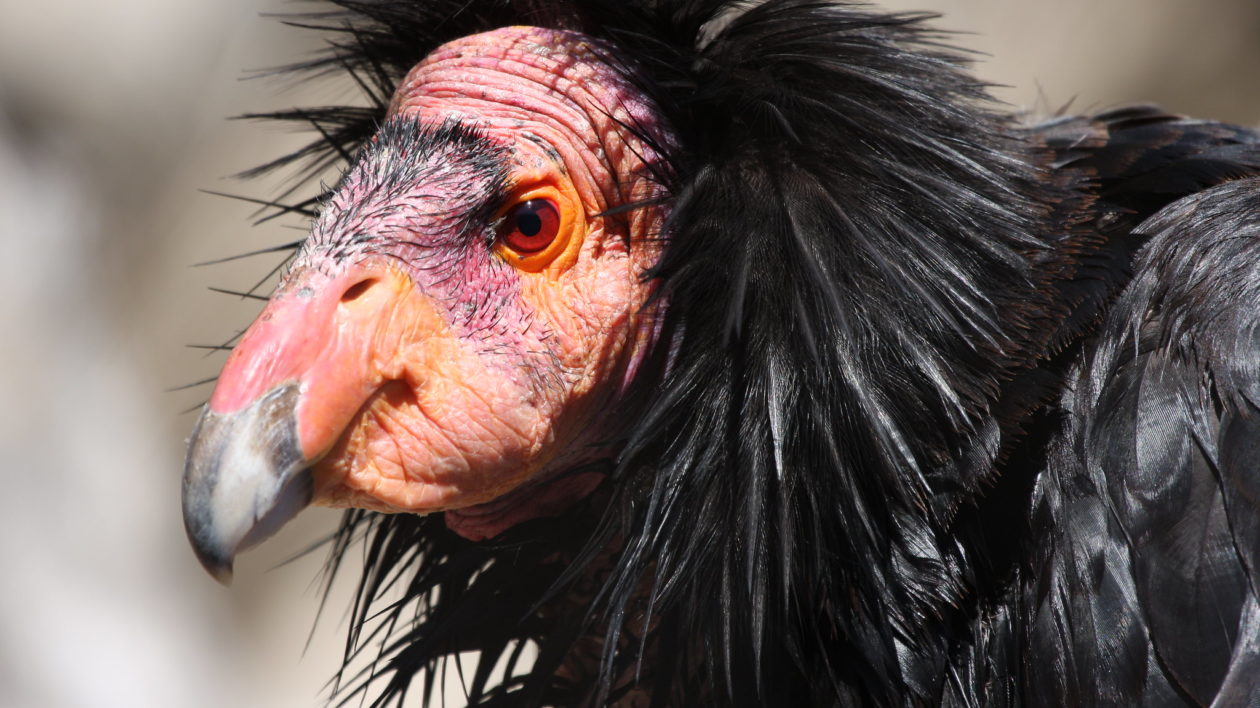
Vultures in the U.S. face poisoning by fragments from lead bullets, often left behind in gut piles during hunting season or in prairie dogs or ground squirrels shot in the prairie and plains.
“When the lead bullet hits the animal, it shatters, and 20 micrograms can kill a bird of prey,” said Meghan Warren, avian care director with the Teton Raptor Center. “Lead poisoning is definitely an issue.”
Vehicle strikes kill vultures as they feed on carcasses of roadkill.
Research can quantify the impact of fewer vultures on the landscape, including work out of India showing fewer vultures lead to more dogs scavenging which increased the rate of rabies, which caused more human deaths by rabies.
So the next time instead of watching vultures soar and wondering what sign they bring of death, I’ll send up a silent note of thanks that they’re doing the dirty work to keep our landscape clean.
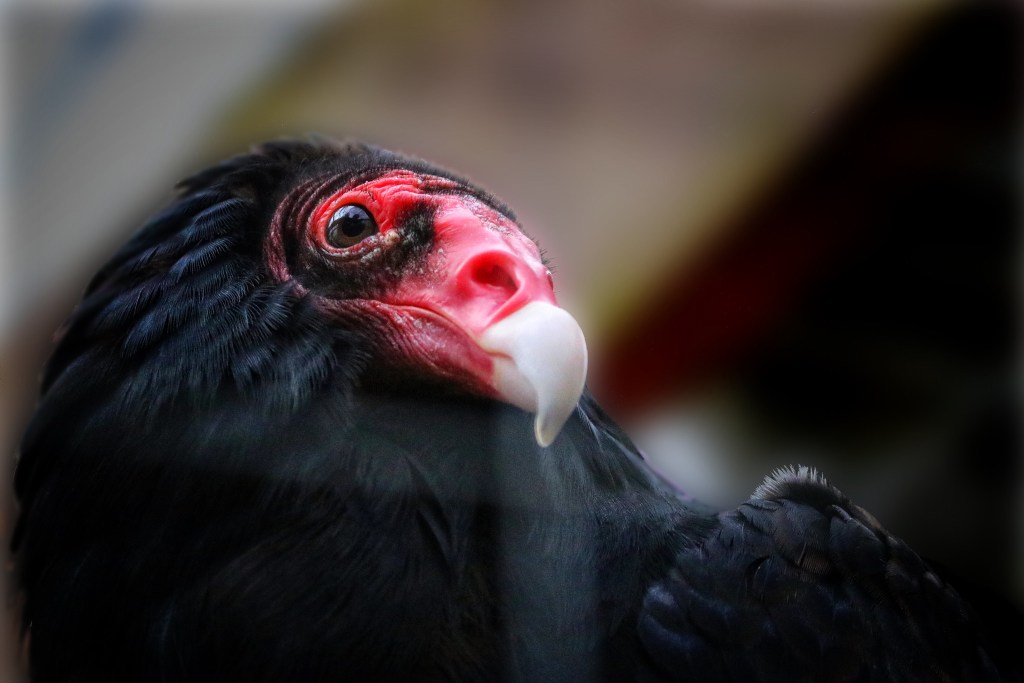



I just recently saw two vulture turkeys in my travels sitting in the trees, first time I’ve ever seen them and was very interested to see them. One of the vultures was sitting on this big branch by the highway but still in the trees. I asked my son who was driving the car if he saw the big bird that was so big the branch he was sitting on was bending down pretty far . My son asked me if it was an owl, I told him no, so he turned around when he was able to because it was the highway and we were trying to see where the bird was driving back towards where I had saw the first one and when we came to the spot then I noticed another one sitting further in the bush from the first bird. We had to turn around and came back to where the birds were and my son was able to see it and took a couple of pictures. We were both excited about seeing them.
I am finding that I went from 1 to 5 black vultures in my little are of my deck and yard. I have had two attack me me coming from above me and then circling me up from the roof which is very close to my deck. They have left a horrible smell too I might add. There is no road kill anywhere near here. It’s by a beautiful stream and I love to feed the birds and even squirrels too. They sit staring at me and my deck and after the attack on me I’m afraid to even go out on my deck. Can you tell me why the aggressive smelly birds are even here and why they are just sitting here in the dusk staring in at me? I don’t want to feed my birds anymore. I am 71 and that’s the only thing I enjoyed was feeding my birds and now these disgusting smelly birds have taken a living small white poodle up and away.
I live in southwest Houston, Texas, and saw a pair of turkey vultures this afternoon on a driveway, picking food up out of the street. They were so large and beautiful even with their ugly red heads. I felt God put them there for me to see, and I feel blessed to have read your article. It was very informative. I’m a researcher by nature and hurried to my computer to read as much as I could about turkey vultures. Yours was a fine and informative article. Thank you. Further, I am an avid birdwatcher, and it was a treat and real surprise to see the pair today!
I live in southwest Houston, Texas, and saw a pair of turkey vultures this afternoon on a driveway, picking food up out of the street. They were so large and beautiful even with their ugly red heads. I felt God put them there for me to see, and I feel blessed to have read your article. It was very informative. I’m a researcher by nature and hurried to my computer to read as much as I could about turkey vultures. Yours was a fine and informative article. Thank you.
There was black vultures at my farm in Ohio yesterday. They seemed agressive.
I walked out my back door 2days ago. There were 4 Vulcers sitting around the rim of my pool. One took and spread it’s wings at me. I”Ve lived here 22 years and it’s the first time since I”v lived here I”Ve seen them land here. Any in put would be appreciated. I Googled the spiritual meaning of seeing them. I”m going thought alot of changes in my life and had just got off my knee”s praying. And that’s ones of the meanings! ” Good omen for changes in your life. “
My house and a large group of grain silos were built on the edge of town (Elizabeth City, NC) 71 years ago. Now the edge of town is over a mile away, and the silos are abandoned. For the past three years, hundreds of turkey vultures have been roosting on the superstructure. Pasquotank County is also a rest stop for migrating Snow Geese and Tundra Swan, and the North River beyond Currituck County (A haven for hunters) is white in Winter. Please give me more information.
Wonderful article, Christine! Though I must correct one point about vulture phylogeny: The cathartid-stork claim has been debunked by replication studies and various phylogenetic analyses, and thus the data used to support this claim ended up being retracted. Phylogenetic studies indicate that New World vultures are the last of their own distinct lineage (Cathartiformes), and their closest living ancestors acthally are those in the order Accipitriformes (ospreys, the Secretarybird, eagles, hawks, Old World vultures, and allies); Cathartiformes and Accipitriformes make up their own distinct clade of birds of prey, Accipitrimorphae, which is among the most basal (aka oldest) groups in the core landbird clade (Telluraves). The similarities between New World vultures and Old World vultures are still examples of convergent evolution, but the relationship between the two groups isn’t as distant as was once suggested. In case you or anyone else is interested, I’ll include a list of studies on New World vulture phylogeny and related topics below (* = italics):
(1) Wink, M. (1995). Phylogeny of Old and New World Vultures (Aves: Accipitridae and Cathartidae) Inferred from Nucleotide Sequences of the Mitochondrial Cytochrome b Gene. *Zeitschrift Für Naturforschung C*, *50*(11-12), 868–882. https://doi.org/10.1515/znc-1995-11-1220
(2) Wink, M., & Sauer-Gürth, H. (2004). Phylogenetic Relationships in Diurnal Raptors Based on Nucleotide Sequences of Mitochondrial and Nuclear Marker Genes. In R. D. Chancellor & B.-U. Meyberg (Eds.), *Raptors Worldwide: Proceedings of the VI World Conference on Birds of Prey and Owls, Budapest, Hungary 18-23 May 2003* (pp. 483–498). World Working Group on Birds of Prey and Owls, MME/BirdLife Hungary.
(3) Ericson, P. G. P., Anderson, C. L., Britton, T., Elzanowski, A., Johansson, U. S., Källersjö, M., Ohlson, J. I., Parsons, T. J., Zuccon, D., & Mayr, G. (2006). Diversification of Neoaves: Integration of Molecular Sequence Data and Fossils. *Biology Letters*, *2*(4), 543–547. https://doi.org/10.1098/rsbl.2006.0523
(4) Gibb, G. C., Kardailsky, O., Kimball, R. T., Braun, E. L., & Penny, D. (2006). Mitochondrial Genomes and Avian Phylogeny: Complex Characters and Resolvability Without Explosive Radiations. *Molecular Biology and Evolution*, *24*(1), 269–280. https://doi.org/10.1093/molbev/msl158
(5) Hackett, S. J., Kimball, R. T., Reddy, S., Bowie, R. C., Braun, E. L., Braun, M. J., Chojnowski, J. L., Cox, W. A., Han, K.-L., Harshman, J., Huddleston, C. J., Marks, B. D., Miglia, K. J., Moore, W. S., Sheldon, F. H., Steadman, D. W., Witt, C. C., & Yuri, T. (2008). A Phylogenomic Study of Birds Reveals Their Evolutionary History. *Science*, *320*(5884), 1763–1768. https://doi.org/10.1126/science.1157704
(6) McCormack, J. E., Harvey, M. G., Faircloth, B. C., Crawford, N. G., Glenn, T. C., & Brumfield, R. T. (2013). A Phylogeny of Birds Based on Over 1,500 Loci Collected by Target Enrichment and High-Throughput Sequencing. PLoS ONE, 8(1), Article e54848. https://doi.org/10.1371/journal.pone.0054848
(7) Jarvis, E. D., Mirarab, S., Aberer, A. J., Li, B., Houde, P., Li, C., Ho, S. Y., Faircloth, B. C., Nabholz, B., Howard, J. T., Suh, A., Weber, C. C., da Fonseca, R. R., Li, J., Zhang, F., Li, H., Zhou, L., Narula, N., Liu, L., … Zhang, G. (2014). Whole-Genome Analyses Resolve Early Branches in the Tree of Life of Modern Birds. *Science*, *346*(6215), 1320–1331. https://doi.org/10.1126/science.1253451
(8) Prum, R. O., Berv, J. S., Dornburg, A., Field, D. J., Townsend, J. P., Lemmon, E. M., & Lemmon, A. R. (2015). A Comprehensive Phylogeny of Birds (Aves) Using Targeted Next-Generation DNA Sequencing. *Nature*, *526*(7574), 569–573. https://doi.org/10.1038/nature15697
(9) Chung, O., Jin, S., Cho, Y. S., Lim, J., Kim, H., Jho, S., Kim, H.-M., Jun, J. H., Lee, H. J., Chon, A., Ko, J., Edwards, J., Weber, J. A., Han, K., O’Brien, S. J., Manica, A., Bhak, J., & Paek, W. K. (2015). The First Whole Genome and Transcriptime of the Cinereous Vulture Reveals Adaptation in the Gastric and Immune Defense Systems and Possible Convergent Evolution Between the Old and New World Vultures. *Genome Biology*, *16*(1), Article 215. https://doi.org/10.1186/s13059-015-0780-4
(10) Johnson, J. A., Brown, J. W., Fuchs, J., & Mindell, D. P. (2016). Multi-locus Phylogenetic Inference Among New World Vultures (Aves: Cathartidae).* Molecular Phylogenetics and Evolution*, *105*, 193–199. https://doi.org/10.1016/j.ympev.2016.08.025
(11) Jiang, L., Peng, L., Tang, M., You, Z., Zhang, M., West, A., Ruan, Q., Chen, W., & Merilä, J. (2019). Complete Mitochondrial Genome Sequence of the Himalayan Griffon, *Gyps Himalayensis* (Accipitriformes: Accipitridae): Sequence, Structure, and Phylogenetic Analyses. Ecology and Evolution, 9(15), 8813–8828. https://doi.org/10.1002/ece3.5433
(12) McClure, C. J., Schulwitz, S. E., Anderson, D. L., Robinson, B. W., Mojica, E. K., Therrien, J.-F., Oleyar, M. D., & Johnson, J. (2019). Commentary: Defining Raptors and Birds of Prey. *Journal of Raptor Research*, *53*(4), 419–430. https://doi.org/10.3356/0892-1016-53.4.419
(13) Houde, P., Braun, E. L., Narula, N., Minjares, U., & Mirarab, S. (2019). Phylogenetic Signal of Indels and the Neoavian Radiation. *Diversity*, *11*(7), Article 108. https://doi.org/10.3390/d11070108
(14) Braun, E. L., Cracraft, J., & Houde, P. (2019). Resolving the Avian Tree of Life from Top to Bottom: The Promise and Potential Boundaries of the Phylogenomic Era. In R. H. S. Kraus (Ed.), *Avian Genomics in Ecology and Evolution: From the Lab into the Wild* (pp. 151–210). Springer International Publishing. https://doi.org/10.1007/978-3-030-16477-5_6
(15) Braun, E. L., & Kimball, R. T. (2021). Data Types and the Phylogeny of Neoaves. *Birds*, *2*(1), 1–22. https://doi.org/10.3390/birds2010001
(16) De Panis, D., Lambertucci, S. A., Wiemeyer, G., Dopazo, H., Almeida, F. C., Mazzoni, C. J., Gut, M., Gut, I., & Padró, J. (2021). Mitogenomic Analysis of Extant Condor Species Provides Insight into the Molecular Evolution of Vultures. *Scientific Reports*, *11*(1), Article 17109. https://doi.org/10.1038/s41598-021-96080-6
(17) Urantówka, A. D., Kroczak, A., Strzała, T., Zaniewicz, G., Kurkowski, M., & Mackiewicz, P. (2021). Mitogenomes of Accipitriformes and Cathartiformes were Subjected to Ancestral and Recent Duplications Followed by Gradual Degeneration. *Genome Biology and Evolution*, *13*(9), Article evab193. https://doi.org/10.1093/gbe/evab193
(18) Zou, D., Tian, S., Zhang, T., Zhuoma, N., Wu, G., Wang, M., Dong, L., Rossiter, S. J., & Zhao, H. (2021). Vulture Genomes Reveal Molecular Adaptations Underlying Obligate Scavenging and Low Levels of Genetic Diversity. *Molecular Biology and Evolution*, *38*(9), 3649–3663. https://doi.org/10.1093/molbev/msab130
Related:
Roggenbuck, M., Bærholm Schnell, I., Blom, N., Bælum, J., Bertelsen, M. F., Sicheritz-Pontén, T., Sørensen, S. J., Gilbert, M. T., Graves, G. R., & Hansen, L. H. (2014). The Microbiome of New World Vultures. *Nature Communications*, *5*(1), Article 5498. https://doi.org/10.1038/ncomms6498
Zepeda Mendoza, M. L., Roggenbuck, M., Manzano Vargas, K., Hansen, L. H., Brunak, S., Gilbert, M. T., & Sicheritz-Pontén, T. (2018). Protective Role of the Vulture Facial Skin and Gut Microbiomes Aid Adaptation to Scavenging. *Acta Veterinaria Scandinavica*, *60*(1), Article 61. https://doi.org/10.1186/s13028-018-0415-3
Wang, W., Gao, X., Zheng, S., Lancuo, Z., Li, Y., Zhu, L., Hou, J., Hai, J., Long, X., Chen, H., Druzyaka, A., & Sharshov, K. (2021). The Gut Microbiome and Metabolome of Himalayan Griffons (Gyps Himalayensis): Insights into the Adaptation to Carrion-Feeding Habits in Avian Scavengers. *Avian Research*, *12*(1), Article 52. https://doi.org/10.1186/s40657-021-00287-0
van Overveld, T., Sol, D., Blanco, G., Margalida, A., de la Riva, M., & Donázar, J. A. (2021). Vultures as an Overlooked Model in Cognitive Ecology. *Animal Cognition*. https://doi.org/10.1007/s10071-021-01585-2
Cailly Arnulphi, V. B., Lambertucci, S. A., & Borghi, C. E. (2017). Education Can Improve the Negative Perception of a Threatened Long-Lived Scavenging Bird, the Andean Condor. *PLOS ONE*, *12*(9), Article e0185278. https://doi.org/10.1371/journal.pone.0185278
Ballejo, F., Plaza, P. I., & Lambertucci, S. A. (2020). The Conflict Between Scavenging Birds and Farmers: Field Observations do Not Support People’s Perceptions. *Biological Conservation*, *248*, Article 108627. https://doi.org/10.1016/j.biocon.2020.108627
Lambertucci, S. A., Margalida, A., Speziale, K. L., Amar, A., Ballejo, F., Bildstein, K. L., Blanco, G., Botha, A. J., Bowden, C. G. R., Cortés‐Avizanda, A., Duriez, O., Green, R. E., Hiraldo, F., Ogada, D., Plaza, P., Sánchez‐Zapata, J. A., Santangeli, A., Selva, N., Spiegel, O., & Donázar, J. A. (2021). Presumed Killers? Vultures, Stakeholders, Misperceptions, and Fake News. *Conservation Science and Practice*, *3*(6), Article e415. https://doi.org/https://doi.org/10.1111/csp2.415
Markandya, A., Taylor, T., Longo, A., Murty, M. N., Murty, S., & Dhavala, K. (2008). Counting the Cost of Vulture Decline—an Appraisal of the Human Health and Other Benefits of Vultures in India. *Ecological Economics*, *67*(2), 194–204. https://doi.org/10.1016/j.ecolecon.2008.04.020
Morales-Reyes, Z., Pérez-García, J. M., Moleón, M., Botella, F., Carrete, M., Lazcano, C., Moreno-Opo, R., Margalida, A., Donázar, J. A., & Sánchez-Zapata, J. A. (2015). Supplanting Ecosystem Services Provided by Scavengers Raises Greenhouse Gas Emissions. *Scientific Reports*, *5*(1), Article 7811. https://doi.org/10.1038/srep07811
Grilli, M. G., Bildstein, K. L., & Lambertucci, S. A. (2019). Nature’s Clean-Up Crew: Quantifying Ecosystem Services Offered by a Migratory Avian Scavenger on a Continental Scale. *Ecosystem Services*, *39*, Article 100990. https://doi.org/10.1016/j.ecoser.2019.100990
Safford, R., Botha, A, Crockford, N., Garbett, R., Margalida, A., Ramírez, I., Shobrak, M., Tavares, J., & Williams, N. P. (2019). Vulture Conservation: The Case for Urgent Action. *Bird Conservation International*, *29*(1), 1–9. https://doi.org/10.1017/s0959270919000042
Berlinguer, F., Ahmed, F., Tamponi, C., Carta, S., Scala, A., Cappai, M. G., & Varcasia, A. (2021). Help From the Sky: Can Vultures Contribute to Cystic Echinococcosis Control in Endemic Areas? *PLOS Neglected Tropical Diseases*, *15*(7), Article e0009615. https://doi.org/10.1371/journal.pntd.0009615
García-Jiménez, R., Pérez-García, J. M., Margalida, A., & Morales-Reyes, Z. (2022). Avian Scavengers’ Contributions to People: The Cultural Dimension of Wildlife-Based Tourism. *Science of The Total Environment*, *806*, Article 150419. https://doi.org/10.1016/j.scitotenv.2021.150419
Botha, A., Buij, R., Coverdale, B., Gore, M. L., Harrell, R. M., Hassell, J., Krüger, S., McClure, C. J., Mullinax, J. M., Shaffer, L. J., Smit-Robinson, H., Thompson, L. J., Van Den Heever, L., & Bowerman, W. W. (2021). A Strategy for Conserving Old World Vulture Populations in the Framework of One Health. *Journal of Raptor Research*, *55*(3), 374–387. https://doi.org/10.3356/jrr-20-98
A lot of farmers and ranchers dislike black vultures because they will aggressively attack newborn animals.
They especially target the eyes, tongue, umbilical cords, genitalia and anus. Finding a calf or lamb with its eyes picked out, or its rear end eaten away, still alive, is a good way to ruin the day.
They are also known to attack the cow or ewe. Usually they are content to eat the afterbirth, but if an animal is weakened they will eat it from the rear end. Coyotes are quick to join in, given half a chance.
They are just birds, doing what they are built to do, but they are definitely not a farmer’s friend.
Turkey vultures, on the other hand, are relatively harmless and are very hesitant to approach anything that might be alive. They serve a valuable purpose and are pretty interesting birds.
I enjoyed your piece on turkey vultures. I work with turkey vulture migration in Washington state. Would it be possible to get a copy of your article?
I’ve never seen the swallows arrive in Capistrano, but I always get a kick out of watching the turkey vultures return to the cottonwoods in the creeks at Galisteo south of Santa Fe, NM. Many of them fan out from there to spend the warm months around Los Alamos, Espanola, and the hills and arroyos near Santa Fe, but a colony of them do stay in those cottonwoods all season. And in the early fall they are all off for the south, to wherever they call home for the winter.
Thanks Christine for an interesting article. Old fears & myths take a long time to overcome!
I live in Central Coast region of CA; we have numerous Turkey vultures, and I was once fortunate enough to see a Condor in the wild while hiking.
Christine Peterson, thank you for the detailed, fascinating and vital information about the benefits of Vulture scavenging.
Sad the people hate them, the undertakers of the world. Another undertaker you could profile are the wonderful American Burying Beetles. Large and colorful they smell dead small prey, go and bury and cover it in spit, thereby preserving them for winter or for the spring time young. The adults and children feed together on the preserved prey. All while underground. We found some at our community garden because several gardeners with sweet potatoes trap voles that try to eat the sweet potatoes. Then dump the dead voles at the edge of the garden area. We noticed they kept dissapearying. Most hawks and foxes do not eat dead prey unless desparate. Finally saw the beetles burying the voles. This year didn’t see the beetles but did see the freshly turned patches where the burials happened. Very unknown beetles to most people. This was in a very large grassland at the Illinois State Fair grounds. Other grassland species breed there, the most rural area in Springfield Illinois.